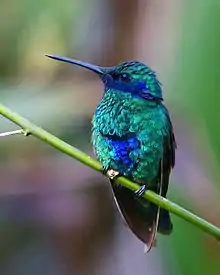Sparkling violetear
The sparkling violetear (Colibri coruscans) is a species of hummingbird widespread in highlands of northern and western South America, including a large part of the Andes (from Argentina and northwards), the Venezuelan Coastal Range, and the Tepuis. It occurs in a wide range of semi-open habitats, even in gardens and parks within major cities such as Quito, and is often the most common species of hummingbird in its range. The sparkling violetear is most abundant near coniferous or evergreen eucalyptus forests. It is highly vocal and territorial.
| Sparkling violetear | |
|---|---|
 | |
| Scientific classification | |
| Kingdom: | Animalia |
| Phylum: | Chordata |
| Class: | Aves |
| Order: | Apodiformes |
| Family: | Trochilidae |
| Genus: | Colibri |
| Species: | C. coruscans |
| Binomial name | |
| Colibri coruscans (Gould, 1846) | |
Description
The sparkling violetear is the largest violetear at 13 to 15 cm (5–6 in) long. Male birds weigh 7.7 to 8.5 grams (0.27 to 0.3 oz) while females weigh from ounces 6.7 to 7.5 grams (0.24 to 0.26 oz). This hummingbird resembles the lesser violetear, but that species generally prefers more humid habitats, is obviously smaller and lacks the distinct purple-blue chest-spot and gorget of the sparkling violetear. According to one study, it has the smallest mean blood-air barrier thickness (0.183 µm) and the highest mass-specific respiratory surface area in birds (87 cm²/g).[2]

Behavior
Sparkling violetears are solitary and aggressive, often defending their territory while singing throughout the day.[3] Breeding seasons vary across territories, with birds in Venezuela mating from July through October.[3] Unlike most male hummingbirds, male sparkling violetears may participate in caring for newborns. The mother lays two eggs, with hatching within two weeks and fledging three weeks later.[3]
Torpor
Sparkling violetears display an extreme level of nighttime torpor to conserve energy during cold temperatures at high altitude, having body temperatures as low as 46 °F (8 °C) during night compared to its daytime body temperature of 96 °F (36 °C).[4][5]
References
- BirdLife International (2012). "Colibri coruscans". IUCN Red List of Threatened Species. 2012. Retrieved 26 November 2013.CS1 maint: ref=harv (link)
- Dubach, M (1981). "Quantitative analysis of the respiratory system of the house sparrow, budgerigar and violet-eared hummingbird". Respir Physiol. 46 (1): 43–60. doi:10.1016/0034-5687(81)90067-0. PMID 7330491.
- "Hummingbirds: Trochilidae - Sparkling violet-ear (Colibri coruscans)". JRank. Retrieved 9 September 2020.
- Wolf, Blair O.; McKechnie, Andrew E.; Schmitt, C. Jonathan; Czenze, Zenon J.; Johnson, Andrew B.; Witt, Christopher C. (2020). "Extreme and variable torpor among high-elevation Andean hummingbird species". Biology Letters. 16 (9): 20200428. doi:10.1098/rsbl.2020.0428. ISSN 1744-9561.
- Veronique Greenwood (8 September 2020). "These hummingbirds take extreme naps. Some may even hibernate". The New York Times. Retrieved 9 September 2020.
